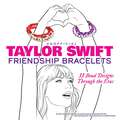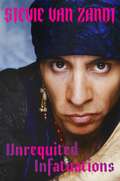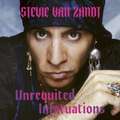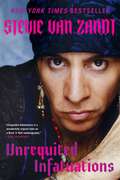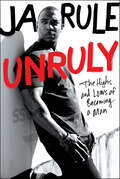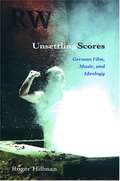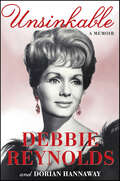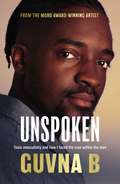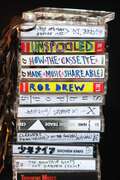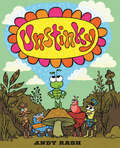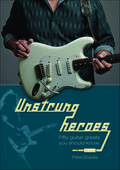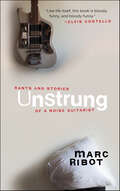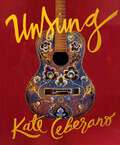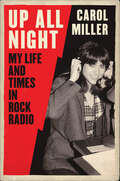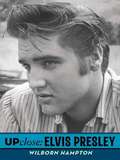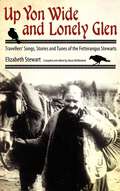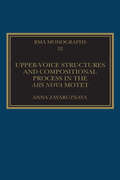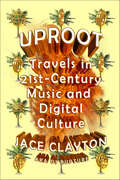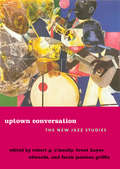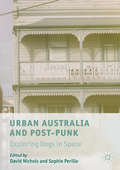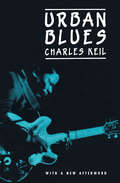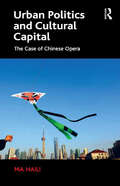- Table View
- List View
Unofficial Taylor Swift Friendship Bracelets: 33 Bead Designs Through the Eras
by Dover PublicationsAre you ready for it? The Unofficial Taylor Swift Friendship Bracelets guide is the ultimate resource for crafting your own stylish, Taylor Swift–inspired bracelets, perfect for swapping with fellow Swifties! This guide features 33 easy-to-make designs, complete with diagrams and vibrant full-color photographs. Each section offers a captivating overview of Taylor’s musical eras, along with 3 unique bracelet ideas that reflect each period’s album and aesthetic. Turn that one simple thread into a cherished keepsake, connecting you to your favorite moments in Taylor’s journey and your friendships with other Swifties!
Unrequited Infatuations: A Memoir
by Stevie Van Zandt'A wonderfully original take on a Rock and Roll autobiography' Paul McCartney'An inimitable Rock 'n' Roll life told as boldly as it was lived' Bruce SpringsteenWhat story begins in a bedroom in suburban New Jersey in the early '60s, unfolds on some of the country's largest stages, and then ranges across the globe, demonstrating over and over again how Rock and Roll has the power to change the world for the better? This story.The first true heartbeat of UNREQUITED INFATUATIONS is the moment when Stevie Van Zandt trades in his devotion to the Baptist religion for an obsession with Rock and Roll. Groups like the Beatles and the Rolling Stones created new ideas of community, creative risk, and principled rebellion. They changed him forever. While still a teenager, he met Bruce Springsteen, a like-minded outcast/true believer who became one of his most important friends and bandmates. As Miami Steve, Van Zandt anchored the E Street Band as they conquered the Rock and Roll world.And then, in the early '80s, Van Zandt stepped away from E Street to embark on his own odyssey. He refashioned himself as Little Steven, a political songwriter and performer, fell in love with Maureen Santoro who greatly expanded his artistic palette, and visited the world's hot spots as an artist/journalist to not just better understand them, but to help change them. Most famously, he masterminded the recording of "Sun City," an anti-apartheid anthem that sped the demise of South Africa's institutionalized racism and helped get Nelson Mandela out of prison.By the '90s, Van Zandt had lived at least two lives-one as a mainstream rocker, one as a hardcore activist. It was time for a third. David Chase invited Van Zandt to be a part of his new television show, the Sopranos-as Silvio Dante, he was the unconditionally loyal consiglieri who sat at the right hand of Tony Soprano (a relationship that oddly mirrored his real-life relationship with Bruce Springsteen).Underlying all of Van Zandt's various incarnations was a devotion to preserving the centrality of the arts, especially the endangered species of Rock. In the twenty-first century, Van Zandt founded a groundbreaking radio show (Underground Garage), a fiercely independent record label (Wicked Cool), and developed a curriculum to teach students of all ages through the medium of music history. He also rejoined the E Street Band for what has now been a twenty-year victory lap.UNREQUITED INFATUATIONS chronicles the twists and turns of Stevie Van Zandt's always surprising life. It is more than just the testimony of a globe-trotting nomad, more than the story of a groundbreaking activist, more than the odyssey of a spiritual seeker, and more than a master class in rock and roll (not to mention a dozen other crafts). It's the best book of its kind because it's the only book of its kind.
Unrequited Infatuations: A Memoir
by Stevie Van Zandt'A wonderfully original take on a Rock and Roll autobiography' Paul McCartney'An inimitable Rock 'n' Roll life told as boldly as it was lived' Bruce SpringsteenWhat story begins in a bedroom in suburban New Jersey in the early '60s, unfolds on some of the country's largest stages, and then ranges across the globe, demonstrating over and over again how Rock and Roll has the power to change the world for the better? This story.The first true heartbeat of UNREQUITED INFATUATIONS is the moment when Stevie Van Zandt trades in his devotion to the Baptist religion for an obsession with Rock and Roll. Groups like the Beatles and the Rolling Stones created new ideas of community, creative risk, and principled rebellion. They changed him forever. While still a teenager, he met Bruce Springsteen, a like-minded outcast/true believer who became one of his most important friends and bandmates. As Miami Steve, Van Zandt anchored the E Street Band as they conquered the Rock and Roll world.And then, in the early '80s, Van Zandt stepped away from E Street to embark on his own odyssey. He refashioned himself as Little Steven, a political songwriter and performer, fell in love with Maureen Santoro who greatly expanded his artistic palette, and visited the world's hot spots as an artist/journalist to not just better understand them, but to help change them. Most famously, he masterminded the recording of "Sun City," an anti-apartheid anthem that sped the demise of South Africa's institutionalized racism and helped get Nelson Mandela out of prison.By the '90s, Van Zandt had lived at least two lives-one as a mainstream rocker, one as a hardcore activist. It was time for a third. David Chase invited Van Zandt to be a part of his new television show, the Sopranos-as Silvio Dante, he was the unconditionally loyal consiglieri who sat at the right hand of Tony Soprano (a relationship that oddly mirrored his real-life relationship with Bruce Springsteen).Underlying all of Van Zandt's various incarnations was a devotion to preserving the centrality of the arts, especially the endangered species of Rock. In the twenty-first century, Van Zandt founded a groundbreaking radio show (Underground Garage), a fiercely independent record label (Wicked Cool), and developed a curriculum to teach students of all ages through the medium of music history. He also rejoined the E Street Band for what has now been a twenty-year victory lap.UNREQUITED INFATUATIONS chronicles the twists and turns of Stevie Van Zandt's always surprising life. It is more than just the testimony of a globe-trotting nomad, more than the story of a groundbreaking activist, more than the odyssey of a spiritual seeker, and more than a master class in rock and roll (not to mention a dozen other crafts). It's the best book of its kind because it's the only book of its kind.
Unrequited Infatuations: A Memoir
by Stevie Van ZandtUncover never-before-told stories in this epic tale of self-discovery by a Rock n Roll disciple and member of the E Street Band. <p><p> What story begins in a bedroom in suburban New Jersey in the early '60s, unfolds on some of the country's largest stages, and then ranges across the globe, demonstrating over and over again how Rock and Roll has the power to change the world for the better? This story. <p><p> The first true heartbeat of Unrequited Infatuations is the moment when Stevie Van Zandt trades in his devotion to the Baptist religion for an obsession with Rock and Roll. Groups like the Beatles and the Rolling Stones created new ideas of community, creative risk, and principled rebellion. They changed him forever. While still a teenager, he met Bruce Springsteen, a like-minded outcast/true believer who became one of his most important friends and bandmates. As Miami Steve, Van Zandt anchored the E Street Band as they conquered the Rock and Roll world. And then, in the early '80s, Van Zandt stepped away from E Street to embark on his own odyssey. He refashioned himself as Little Steven, a political songwriter and performer, fell in love with Maureen Santoro who greatly expanded his artistic palette, and visited the world’s hot spots as an artist/journalist to not just better understand them, but to help change them. Most famously, he masterminded the recording of “Sun City,” an anti-apartheid anthem that sped the demise of South Africa’s institutionalized racism and helped get Nelson Mandela out of prison. <p><p> By the '90s, Van Zandt had lived at least two lives—one as a mainstream rocker, one as a hardcore activist. It was time for a third. David Chase invited Van Zandt to be a part of his new television show, the Sopranos—as Silvio Dante, he was the unconditionally loyal consiglieri who sat at the right hand of Tony Soprano (a relationship that oddly mirrored his real-life relationship with Bruce Springsteen). Underlying all of Van Zandt's various incarnations was a devotion to preserving the centrality of the arts, especially the endangered species of Rock. <p><p> In the twenty-first century, Van Zandt founded a groundbreaking radio show (Little Steven's Underground Garage), created the first two 24/7 branded music channels on SiriusXM (Underground Garage and Outlaw Country), started a fiercely independent record label (Wicked Cool), and developed a curriculum to teach students of all ages through the medium of music history. He also rejoined the E Street Band for what has now been a twenty-year victory lap. Unrequited Infatuations chronicles the twists and turns of Stevie Van Zandt’s always surprising life. It is more than just the testimony of a globe-trotting nomad, more than the story of a groundbreaking activist, more than the odyssey of a spiritual seeker, and more than a master class in rock and roll (not to mention a dozen other crafts). It's the best book of its kind because it's the only book of its kind.
Unruly: The Highs and Lows of Becoming a Man
by Ja RuleJa Rule, actor, singer, songwriter, and one of the most multi-dimensional rap artists of his time, tells his compelling story—from his youth to his rise to international fame to his transformative two years in Federal prison—and reveals the man beneath the legend.Unruly is two stories that offer one complete picture of a man and his world: the angry, fatherless rapper, Ja Rule who was “raised by the streets”; and Jeffrey Atkins, the insightful, reflective father and loyal husband who learned the hard way how to be a good man.Filled with never-before-revealed anecdotes and sixteen pages of black-and-white photos, Unruly shows the determination that it takes to become a man in today’s society. Ja Rule considers the lack of role models for many young black men today—a void that leads to bad choices and the wrong paths. Recalling his youth, he illuminates the seductive pull of the streets and the drug dealers who were his earliest role models.Jeffrey Atkins offers practical wisdom—reflection, growth and hope learned first-hand as an inmate, father, husband, and community role model. He speaks fondly of men who inspired Unruly—the inmates he met in prison whose misguided ideas of masculinity landed them behind bars—and Louis Farrakhan who mediated the televised encounter with Ja Rule’s adversary, 50 Cent.Unruly is a compelling, personal look at the duality and conflicts that arise in the African-American male psyche from a man who has enjoyed breathtaking fame and suffered heartbreaking misfortune.
Unsettled Scores: Politics, Hollywood, and the Film Music of Aaron Copland and Hanns Eisler (Music in American Life #489)
by Sally BickThe Hollywood careers of Aaron Copland and Hanns Eisler brought the composers and their high art sensibility into direct conflict with the premier producer of America's potent mass culture. Drawn by Hollywood's potential to reach—and edify—the public, Copland and Eisler expertly wove sophisticated musical ideas into Hollywood and, each in their own distinctive way, left an indelible mark on movie history. Sally Bick's dual study of Copland and Eisler pairs interpretations of their writings on film composing with a close examination of their first Hollywood projects: Copland's music for Of Mice and Men and Eisler's score for Hangmen Also Die! Bick illuminates the different ways the composers treated a film score as means of expressing their political ideas on society, capitalism, and the human condition. She also delves into Copland's and Eisler's often conflicted attempts to adapt their music to fit Hollywood's commercial demands, an enterprise that took place even as they wrote hostile critiques of the film industry.
Unsettling Scores: German Film, Music, and Ideology
by Roger Hillman"Hillman's groundbreaking study enables both serious and casual film students to approach these works with sharpened vision and improved hearing." --Klaus Phillips, Hollins UniversityUnsettling Scores: German Film, Music, and Ideology examines the use of classical music in film, particularly in the New German Cinema of the 1970s and early 80s. By integrating the music of Beethoven, Mahler, and others into their films, directors such as Fassbinder, Kluge, and Syberberg consciously called attention to its cultural significance. Through this music their films could reference and, in some cases, explore an embedded cultural tradition that included German nationalism and the rise of Nazism, especially during a period when German films were gaining international attention for the first time since the 1920s. Classical music conditioned the responses of German audiences and was, in turn, reinterpreted in new cinematic contexts. In this pioneering volume, Hillman enriches our understanding of the powerful effects of music in cinema and the aesthetic and dramatic concerns of postwar German filmmakers.
Unsinkable: A Memoir
by Debbie Reynolds Dorian HannawayUnsinkable is the definitive memoir by film legend and Hollywood icon Debbie Reynolds.In Unsinkable, the late great actress, comedienne, singer, and dancer Debbie Reynolds shares the highs and lows of her life as an actress during Hollywood’s Golden Age, anecdotes about her lifelong friendship with Elizabeth Taylor, her experiences as the foremost collector of Hollywood memorabilia, and intimate details of her marriages and family life with her children, Carrie and Todd Fisher.A story of heartbreak, hope, and survival, “America’s Sweetheart” Debbie Reynolds picks up where she left off in her first memoir, Debbie: My Life, and is illustrated with previously unpublished photos from Reynolds’s personal collection.Debbie Reynolds died on December 28, 2016, at the age of 84, just one day after the death of her daughter, actress and author Carrie Fisher.
Unspoken: Toxic Masculinity and How I Faced the Man Within the Man
by Guvna BMen are bold. Men are brave. Men are strong in the face of fear. But what happens when that strength crumbles? Growing up on a council estate in East London, rapper Guvna B thought he knew everything he needed to know about what it means to be a man. But when a personal tragedy sent him reeling, he knew he had to face these assumptions head on if he was going to be able to overcome his grief. In this intimate, honest and unflinching memoir, Guvna B draws on his personal experiences to explore how toxic masculinity affects young men today. Exploring ideas of male identity, UNSPOKEN is an inspirational account of Guvna’s journey.
Unspooled: How the Cassette Made Music Shareable (Sign, Storage, Transmission)
by Rob DrewWell into the new millennium, the analog cassette tape continues to claw its way back from obsolescence. New cassette labels emerge from hipster enclaves while the cassette’s likeness pops up on T-shirts, coffee mugs, belt buckles, and cell phone cases. In Unspooled, Rob Drew traces how a lowly, hissy format that began life in office dictation machines and cheap portable players came to be regarded as a token of intimate expression through music and a source of cultural capital. Drawing on sources ranging from obscure music zines to transcripts of Congressional hearings, Drew examines a moment in the early 1980s when music industry representatives argued that the cassette encouraged piracy. At the same time, 1980s indie rock culture used the cassette as a symbol to define itself as an outsider community. Indie’s love affair with the cassette culminated in the mixtape, which advanced indie’s image as a gift economy. By telling the cassette’s long and winding history, Drew demonstrates that sharing cassettes became an acceptable and meaningful mode of communication that initiated rituals of independent music recording, re-recording, and gifting.
Unstinky
by Andy RashAndy Rash brings the laughs in this humorous story of a stinkbug who can't stink.Bud is a happy stinkbug, except when it comes to stinking contests.He always seems to lose to champions like P. U. Bottoms, Lord Stinkington, and The Fumigator.Every time they make smells like OUTHOUSE, GYM SOCK, and ARMPIT, poor Bud ends up smelling like FLOWERS, or FRESH-BAKED BREAD, or CANDY CANE.Stinking just isn't Bud's THING. But what IS his thing?With an ending as fresh as a daisy, and funnier than any funny smell, Andy Rash puts a hilarious spin on a tale of following your nose to happiness.
Unstrung Heroes: Fifty Guitar Greats You Should Know
by Pete BraidisInterviews with 50 guitar players you've no doubt heard but may not know by nameGuitar players from pop to jazz to heavy metal and folk, from the 1960s to the present dayAn insider's look behind the scenes of some of the greatest music ever recorded
Unstrung: Rants and Stories of a Noise Guitarist
by Marc RibotThe paperback edition of iconoclastic guitar player Marc Ribot’s darkly funny and subversive collection of writing, featuring brand-new essays not included in the hardcover.“A slim yet powerful book in which Marc Ribot blends bits of memoir with strange little fictions, many of which are based on his own life and career.” —Wall Street JournalThroughout his genre-defying career as one of the most innovative musicians of our time, iconoclastic guitar player Marc Ribot has consistently defied expectation at every turn. Here, in the expanded paperback edition of Ribot’s first collection of writing, we see that same uncompromising sensibility at work as he playfully interrogates our assumptions about music, life, and death. Through essays—including some new material not included in the hardcover—short stories, and the occasional unfilmable film “mistreatment” that showcase the sheer range of his voice, Unstrung captures an artist whose versatility on the page rivals his dexterity onstage. In the first section of the book, "Lies and Distortion," Ribot turns his attention to his instrument--"my relation to the guitar is one of struggle; I'm constantly forcing it to be something else"--and reflects on his influences (and friends) like Robert Quine (the Voidoids) and producer Hal Willner (Saturday Night Live), while delivering an impassioned plea on behalf of artists' rights. Elsewhere, we glimpse fragments of Ribot's life as a traveling musician--he captures both the monotony of touring as well as small moments of beauty and despair on the road. In the heart of the collection, "Sorry, We're Experiencing Technical Difficulties," Ribot offers wickedly humorous short stories that synthesize the best elements of the Russian absurdist tradition with the imaginative heft of George Saunders. Taken together, these stories and essays cement Ribot's position as one of the most dynamic and creative voices of our time.
Unsung: A Compendium of Creativity
by Kate CeberanoA beautiful illustrated memoir from beloved Australian musician Kate Ceberano, featuring her inspirational song lyrics, stories, paintings and embroidery, and celebrating four decades of songwriting and recording on the release of her 30th album. Kate Ceberano is used to a hush descending as she draws breath to release that magnificent voice but when the whole world quietened in 2020, she found the silence disorientating. Without an audience or long hours of travel with her tribe of musicians, there was time to think. But what does an artist do when they can&’t make art? They find a way. With characteristic passion, abundance and joy, Kate liberated her unsung songs. They flowed through her paintbrush as she embellished guitars, her needle as she stitched quilts to envelop her beloveds and her pen as she unfurled stories, poems and songs. In Unsung Kate muses on the people and experiences that have inspired her, on what has humbled her, what hurts and what sustains. This is the story of a powerful woman in her prime, but also of a reflective, romantic and vulnerable artist making sense of the universe. It&’s proof of a lifetime lived in music. It&’s a tribute to songs, wherever they come from and wherever they go.
Untimely Meditations
by Friedrich NietzscheThe four short works in Untimely Meditations were published by Nietzsche between 1873 and 1876. They deal with such broad topics as the relationship between popular and genuine culture, strategies for cultural reform, the task of philosophy, the nature of education, and the relationship between art, science and life. They also include Nietzsche's earliest statement of his own understanding of human selfhood as a process of endlessly â becoming who one is'. As Daniel Breazeale shows in his introduction to this new edition of R. J. Hollingdale's translation of the essays, these four early texts are key documents for understanding the development of Nietzsche's thought and clearly anticipate many of the themes of his later writings. Nietzsche himself always cherished his Untimely Meditations and believed that they provide valuable evidence of his â becoming and self-overcoming' and constitute a â public pledge' concerning his own distinctive task as a philosopher.
Up All Night: My Life and Times in Rock Radio
by Carol MillerCarol Miller is indisputably America’s premiere female rock ’n’ roll disc jockey, as her well-deserved induction into the Rock and Roll Hall of Fame proves.In her illuminating, fascinating, sometimes heartbreaking memoir, Up All Night, the legendary “Nightbird” tells the story of her colorful career—her rise to success in a male-dominated music industry; her close and personal dealings with rock royalty like Bruce Springsteen (whose music she first introduced to New York radio), Sir Paul McCartney, and Steven Tyler (whom she dated)—and details openly and honestly her battle against breast cancer for the very first time.
Up Close: Elvis Presley
by Wilborn HamptonFor fans of the king, the newest installment to the Up Close biography series! Elvis Presley made a sound so different it ushered in a new kind of music: rock and roll. He was able to combine gospel, honky-tonk, country and rhythm and blues to create a unique sound that crossed racial and cultural divides. Though he was incredibly popular, at heart, Elvis was a shy and polite man, and the demands of fame began to take a toll. While his dependence on prescription drugs cut short his life, Elvis's influence on music and popular culture endures to this day.
Up Jumped the Devil: The Real Life of Robert Johnson
by Gayle Dean Wardlow Bruce ConforthRobert Johnson is the subject of the most famous myth about the history of the blues: he allegedly sold his soul at the crossroads in exchange for his incredible talent, and this deal led to his tragic death at age 27. This single notion can be recited by everyone who has ever heard of him, but the actual story of his life remains unknown save for a few inaccurate anecdotes. Up Jumped the Devil is the result of over 50 years of research. Gayle Dean Wardlow has been interviewing people who knew Robert Johnson since the early 1960s, and he was the person who discovered Johnson's death certificate in 1967. Bruce Conforth began his study of Johnson's life and music in 1970 and made it his personal mission to try to fill in the gaps in what was still unknown about him. In this definitive biography, the two authors relied on every possible interview, resource and document, most of it material that no one has ever seen before. As a result, this book not only destroys every myth that ever surrounded Johnson, but also tells a very human and tragic story of a real person. It is the first book about Johnson that documents his years in Memphis, details his trip to New York, uncovers where and when his wife Virginia died and the impact this had on him, fully portrays the other women Johnson was involved with, and tells exactly how and why he died and who gave him the poison that killed him. Up Jumped the Devil will astonish blues fans who thought they knew something about Johnson—most of those things are wrong—and will be a great read for anyone interested in blues, black culture and American music.
Up Yon Wide and Lonely Glen: Travellers' Songs, Stories and Tunes of the Fetterangus Stewarts
by Elizabeth StewartElizabeth Stewart is a highly acclaimed singer, pianist, and accordionist whose reputation has spread widely not only as an outstanding musician but as the principal inheritor and advocate of her family and their music. First discovered by folklorists in the 1950s, the Stewarts of Fetterangus, including Elizabeth's mother Jean, her uncle Ned, and her aunt Lucy, have had immense musical influence. Lucy in particular became a celebrated ballad singer and in 1961 Smithsonian Folkways released a collection of her classic ballad recordings that brought the family's music and name to an international audience. Up Yon Wide and Lonely Glen is a significant memoir of Scottish Traveller life, containing stories, music, and songs from this prominent Traveller family. The book is the result of a close partnership between Elizabeth Stewart and Scottish folk singer and writer Alison McMorland. It details the ancestral history of Elizabeth Stewart's family, the story of her mother, the story of her aunt, and her own life story, framing and contextualizing the music and song examples and showing how totally integrated these art forms are with daily life. It is a remarkable portrait of a Traveller family from the perspective of its matrilineal line. The narrative, spanning five generations and written in Scots, captures the rhythms and idioms of Elizabeth Stewart's speaking voice and is extraordinary from a musical, cultural, sociological, and historical point of view. The book features 145 songs, eight original piano compositions, folktale versions, rhymes and riddles, and eighty fascinating illustrations, from the family of Elizabeth, her mother Jean (1912–1962) and her aunt Lucy (1901–1982). In addition, there are notes on the songs and a series of appendices. Up Yon Wide and Lonely Glen will appeal to those interested in traditional music, folklore, and folk song—and in particular, Scottish tradition.
Upper-Voice Structures and Compositional Process in the Ars Nova Motet (Royal Musical Association Monographs)
by Anna ZayaruznayaIn the motets of Philippe de Vitry, Guillaume de Machaut, and their contemporaries, tenors have often been characterized as the primary shaping forces, prior in conception as well as in construction to the upper voices. Tenors are shaped by the interaction of talea and color, medieval terms now used to refer to the independent repetition of rhythms and pitches, respectively. The presence in the upper voices of the periodically repeating rhythmic patterns, often referred to as "isorhythm," has been characterized as an amplification of tenor structure. But a fresh look at the medieval treatises suggests a revised analytical vocabulary: for many fourteenth- and fifteenth-century writers, both color and talea involved rhythmic repetition, the latter in the upper voices specifically. And attention to upper-voice taleae independently of tenor structures brings renewed emphasis to the significant portion of the repertory in which upper voices evince formal schemes that differ from those in the tenors. These structures in turn suggest a revision of the presumed compositional process for motets, implying that in some cases upper-voice text and forms may have preceded the selection and organization of tenors. Such revisions have implications for hermeneutic endeavors, since not only the forms of motet voices but the meanings of their texts change, depending on whether analysis proceeds from the tenor up, or from the top down. Where the presumed compositional and structural primacy afforded to tenors has encouraged a strand of interpretation that reads the upper-voice poetry as conforming to, and amplifying, the tenor text snippets and their liturgical contexts, a "bottom-down" view casts tenors in a supporting role and reveals the poetic impulse of the upper voices as the organizing principle of motets.
Uproot: Travels in 21st-Century Music and Digital Culture
by Jace Clayton“A meditation on how sounds are made, circulated and used by people around the world.” —GuardianIn 2001, Jace Clayton was an amateur DJ who recorded a three-turntable, sixty-minute mix called Gold Teeth Thief and put it online to share with his friends. Within months, the mix became an international calling card, whisking Clayton away to a sprawling, multitiered nightclub in Zagreb, a tiny gallery in Osaka, a former brothel in São Paolo, and the atrium of MoMA. And just as the music world made its fitful, uncertain transition from analog to digital, Clayton found himself on the front lines of an education in the creative upheavals of art production in the twenty-first-century globalized world.Uproot is a guided tour of this newly opened cultural space, mapped with both his own experiences and his relationships with other industry game-changers such as M.I.A. and Pirate Bay. With humor, insight, and expertise, Clayton illuminates the connections between a Congolese hotel band and the indie rock scene, Mexican surfers and Israeli techno, Japanese record collectors and hidden rain-forest treasure, and offers an unparalleled understanding of music in a digital age. Uproot takes readers behind the turntable decks to tell a story that only a DJ—and writer—of this caliber can tell.
Uptown Conversation: The New Jazz Studies
by Farah Jasmine Griffin Brent Hayes Edwards Robert G. O'MeallyJackson Pollock dancing to the music as he painted; Romare Bearden's stage and costume designs for Alvin Ailey and Dianne McIntyre; Stanley Crouch stirring his high-powered essays in a room where a drumkit stands at the center: from the perspective of the new jazz studies, jazz is not only a music to define—it is a culture. Considering musicians and filmmakers, painters and poets, the intellectual improvisations in Uptown Conversation reevaluate, reimagine, and riff on the music that has for more than a century initiated a call and response across art forms, geographies, and cultures. Building on Robert G. O'Meally's acclaimed Jazz Cadence of American Culture, these original essays offer new insights in jazz historiography, highlighting the political stakes in telling the story of the music and evaluating its cultural import in the United States and worldwide. Articles contemplating the music's experimental wing—such as Salim Washington's meditation on Charles Mingus and the avant-garde or George Lipsitz's polemical juxtaposition of Ken Burns's documentary Jazz and Horace Tapscott's autobiography Songs of the Unsung—share the stage with revisionary takes on familiar figures in the canon: Thelonious Monk, Miles Davis, Duke Ellington, and Louis Armstrong.
Urban Australia and Post-Punk: Exploring Dogs in Space
by David Nichols Sophie PerilloRichard Lowenstein’s 1986 masterpiece Dogs in Space was and remains controversial, divisive, compelling and inspirational. Made less than a decade after the events it is based on, using many of the people involved in those events as actors, the film explored Melbourne’s ‘postpunk’ counterculture of share houses, drugs and decadence. Amongst its ensemble cast was Michael Hutchence, one of the biggest music stars of the period, in his acting debut. This book is a collection of essays exploring the place, period and legacy of Dogs in Space, by people who were there or who have been affected by this remarkable film. The writers are musicians, actors and artists and also academics in heritage, history, urban planning, gender studies, geography, performance and music. This is an invaluable resource for anyone passionate about Australian film, society, culture, history, heritage, music and art.
Urban Blues
by Charles KeilCharles Keil examines the expressive role of blues bands and performers and stresses the intense interaction between performer and audience. Profiling bluesmen Bobby Bland and B. B. King, Keil argues that they are symbols for the black community, embodying important attitudes and roles--success, strong egos, and close ties to the community. While writing Urban Blues in the mid-1960s, Keil optimistically saw this cultural expression as contributing to the rising tide of raised political consciousness in Afro-America. His new Afterword examines black music in the context of capitalism and black culture in the context of worldwide trends toward diversification. "Enlightening. . . . [Keil] has given a provocative indication of the role of the blues singer as a focal point of ghetto community expression. "--John S. Wilson, New York Times Book Review "A terribly valuable book and a powerful one. . . . Keil is an original thinker and . . . has offered us a major breakthrough. "--Studs Terkel, Chicago Tribune "[Urban Blues] expresses authentic concern for people who are coming to realize that their past was . . . the source of meaningful cultural values. "--Atlantic "An achievement of the first magnitude. . . . He opens our eyes and introduces a world of amazingly complex musical happening. "--Robert Farris Thompson, Ethnomusicology "[Keil's] vigorous, aggressive scholarship, lucid style and sparkling analysis stimulate the challenge. Valuable insights come from treating urban blues as artistic communication. "--James A. Bonar, Boston Herald
Urban Politics and Cultural Capital: The Case of Chinese Opera
by Ma HailiThis book tells the story of how a regional Chinese theatrical form, Shanghai Yue Opera, evolved from the all-male ’beggar’s song’ of the early twentieth century to become the largest all-female opera form in the nation, only to face increasing pressure to survive under Chinese political and economic reforms in the new millennium. Previous publications have focused mainly on the historical development of Chinese theatre, with emphasis placed on Beijing opera. This is the first book to take an interdisciplinary approach to the story of the Shanghai Yue Opera, bringing history, arts management, central and regional government policy, urbanisation, gender, media, and theatre artistic development in one. Through the story of the Shanghai Yue Opera House market reform this book facilitates an understanding of the complex Chinese political economic situation in post-socialist China. This book suggests that as state art institutions are key organs of the Communist party gaining legitimacy, the vigorous evolution and struggle of the Shanghai Yue Opera house in fact directly mirrors the Communist Party internal turmoil in the new millennium to gain its own legitimacy and survival.
